Add color, art and stunning designs to your collection with paper money

More and more of our coin customers are expanding their collections to include paper money. And for good reason. Paper money, and especially the older large-size currency, brings eye-catching color, impressive artwork and sophisticated designs to any collection!
Intricate designs discourage forgers
Paper money has always been targeted by counterfeiters. So its designs are carefully created to make duplication as difficult as possible. Modern paper currency features extensive security devices including micro-printing, fluorescent security threads, optically variable ink, holograms and watermarks. But older bank notes simply relied on intricate typography, detailed illustrations, ornate borders and other elements by the finest artists and engravers of their time. These artisans performed their magic on several types of American currency:
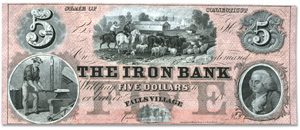 Obsolete Bank Notes – before federal paper money debuted during the Civil War, private banks issued their own currency. Each design was unique, and each note bore the name and location of the bank. So collectors can enjoy “obsoletes” from their home town, region or state.
Obsolete Bank Notes – before federal paper money debuted during the Civil War, private banks issued their own currency. Each design was unique, and each note bore the name and location of the bank. So collectors can enjoy “obsoletes” from their home town, region or state.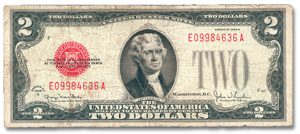 Legal Tender Notes – introduced during the Civil War and also known as United States Notes, these were the first circulating U.S. bank notes. Famous Legal Tender Note designs include the “rainbow” notes, “woodchopper” notes, “bison” note and “sawhorse” reverse.
Legal Tender Notes – introduced during the Civil War and also known as United States Notes, these were the first circulating U.S. bank notes. Famous Legal Tender Note designs include the “rainbow” notes, “woodchopper” notes, “bison” note and “sawhorse” reverse.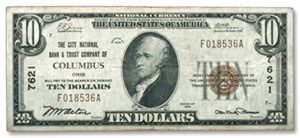 National Bank Notes & produced from 1863-1929, National Bank Notes display the name and city of the issuing national bank as well as the bank’s four-digit federal charter number. So these popular collectibles offer local and regional as well as national interest.
National Bank Notes & produced from 1863-1929, National Bank Notes display the name and city of the issuing national bank as well as the bank’s four-digit federal charter number. So these popular collectibles offer local and regional as well as national interest.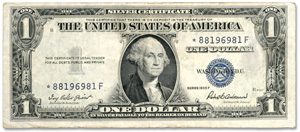 Silver Certificates – issued from 1878 until the 1960s and once redeemable for silver coins or bullion. Famous issues include Series 1896 Educational Notes with stunning illustrations, Series 1899 “Black Eagle” Notes and Series 1899 “Indian Chief” Notes.
Silver Certificates – issued from 1878 until the 1960s and once redeemable for silver coins or bullion. Famous issues include Series 1896 Educational Notes with stunning illustrations, Series 1899 “Black Eagle” Notes and Series 1899 “Indian Chief” Notes.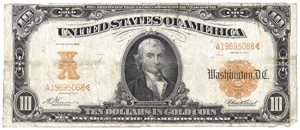 Gold Certificates – issued from 1865 until the early 1930s with distinct golden-orange coloring and once redeemable for gold coins on demand. Most were redeemed after FDR’s 1933 Gold Recall Order that made these notes illegal to own until the 1960s.
Gold Certificates – issued from 1865 until the early 1930s with distinct golden-orange coloring and once redeemable for gold coins on demand. Most were redeemed after FDR’s 1933 Gold Recall Order that made these notes illegal to own until the 1960s.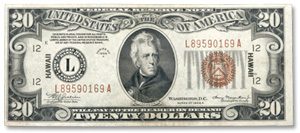 Federal Reserve Notes – legislation in 1913 created the Federal Reserve System and currency known as Federal Reserve Notes. These are the notes we know and use today and are the only type of U.S. paper currency issued since the mid-20th century.
Federal Reserve Notes – legislation in 1913 created the Federal Reserve System and currency known as Federal Reserve Notes. These are the notes we know and use today and are the only type of U.S. paper currency issued since the mid-20th century.
Popular ways to collect paper money
- Some collectors enjoy owning a $1 or $5 bill of each type listed above – Legal Tender Note, Silver Certificate, Federal Reserve Note etc.
- Other collectors strive to assemble one of each denomination ($1, $2, $5, $10, $20 etc.) within a type of paper currency.
- A larger goal is to own one of each denomination and design within a currency type ($1 Legal Tender Notes went through several different designs).
- Until the 1920s, U.S. bank notes measured a big 7-3/8″ x 3-1/8″ and some collectors specialize in this older “large-size” currency.
- Other collectors concentrate on “small-size” bank notes from the 1920s to date which are more available and affordable.
Special types of collectible currency
Special-issue paper currency has been produced during particular eras or events in America history. The Civil War era gave collectors two fascinating types of collectible paper money:
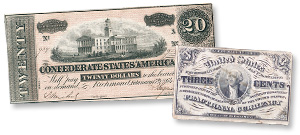 Confederate Currency was issued by the Confederate States of America in denominations of 50¢ to $1,000 from 1861-1864. Fractional Currency was issued by the Union in denominations of 3¢ to 50¢ from 1862-1876 to address a war-era coin shortage due to hoarding.
Confederate Currency was issued by the Confederate States of America in denominations of 50¢ to $1,000 from 1861-1864. Fractional Currency was issued by the Union in denominations of 3¢ to 50¢ from 1862-1876 to address a war-era coin shortage due to hoarding.
Emergency conditions during World War II created two types of special currency which could be easily identified and demonetized if large quantities fell into enemy hands:
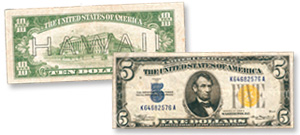 After the Japanese attack on Pearl Harbor, Hawaii Emergency Notes with special brown serial numbers and seals and with hawaii overprints on each side of the face and across the back were issued in the Hawaiian Islands. And when U.S. troops landed on the beaches of North Africa in November of 1942, they carried North Africa Emergency Notes consisting of $1, $5 and $10 Silver Certificates with distinctive yellow seals.
After the Japanese attack on Pearl Harbor, Hawaii Emergency Notes with special brown serial numbers and seals and with hawaii overprints on each side of the face and across the back were issued in the Hawaiian Islands. And when U.S. troops landed on the beaches of North Africa in November of 1942, they carried North Africa Emergency Notes consisting of $1, $5 and $10 Silver Certificates with distinctive yellow seals.
Other special types of currency can be found right in your pocket! Sought-after “Star Notes” have an asterisk next to their serial numbers – indicating they were replacements for notes damaged during production. And notes with certain serial numbers are prized by collectors. These include “ladders” (1,2,3,4 etc.), “radars” that read the same backward and forward (63477436), “repeaters” (58295829), binaries made up of only two digits (96996966) and others. Happy hunting!
Follow your interests to get started!

Whether you try collecting older large-size U.S. bank notes or colorful modern issues from around the world, you’ll find that paper money adds great visual interest to your collection. Take time to examine the intricate typography and illustrations… It’s sure to spur your interest in paper money artistry!
Do you appreciate and collect paper money? Please share your comments or suggestions with our other readers…



